 |
FOR IMMEDIATE RELEASE
October 8, 2008
CONTACTS:
Gina Hebert, Marine Biological Laboratory, 508-289-7725; ghebert@mbl.edu
Diana Kenney, Marine Biological Laboratory, 508-289-7139; dkenney@mbl.edu
MBL Scientist Osamu Shimomura Wins Nobel Prize in Chemistry for Discovery Of Green Fluorescent Protein
|
Watch the press conference from October 8, 2008
Watch Streaming Video
Download the video
In the Media:
Read More:
Dr. Shimomura's "A Short Story of Aequorin", published in The Biological Bulletin, August 1995. (PDF format)
"Shedding Light on Luminescence," from LabNotes, 1995
Dr. Shimomura is the 53rd scientist affiliated with the MBL since its founding in 1888 to receive the Nobel Prize. View the list of MBL Nobelists here.
External links:
For more information or to schedule an interview with Dr. Shimomura, please contact the MBL Communications Department at 508-289-7423.
|
 |
Photos: Click on thumbnails for larger images.
|
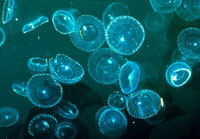
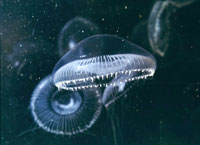
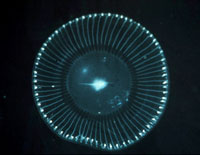
Aequorea, the jellyfish from which Osamu Shimomura first purified green fluorescent protein. Credit: Osamu Shimomura
|
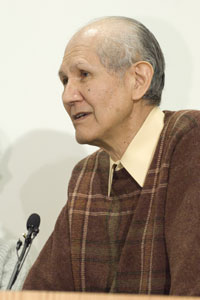
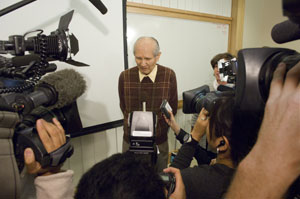
Osamu Shimomura speaks to reporters at the MBL following the announcement of his Nobel Prize in Chemistry. Photo credit, Tom Kleindinst
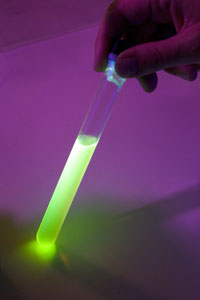
Green fluorescent protein (GFP) purified by Osamu Shimomura from Aequorea. GFP glows bright green when hit with ultraviolet or blue light, a property that allows scientists to use it as a glowing tag inside cells. Photo credit, Tom Kleindinst
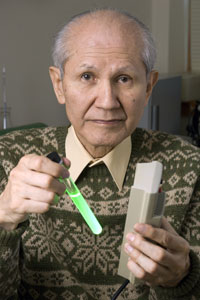
Osamu Shimomura holds a test tube containing green fluorescent protein (GFP) in a water solution. He also holds a lamp that shines ultraviolet light, which causes the GFP to fluoresce bright green. Dr. Shimomura purified this small amount of GFP from 20,000 Aequorea specimens. Credit: Tom Kleindinst
|
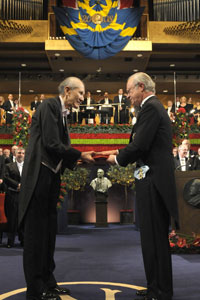 |
 |
The 2008 Nobel Prize winner in chemistry, U.S. scientist Osamu Shimomura, (L) receives his medal from the Swedish King Carl XVI Gustaf in the concert hall, in Stockholm, 10 December 2008. Japanese-born Shimomura was awarded the Prize for the discovery and development of the green fluorescent protein, GFP. Photo Credit: Fredrik Sandberg/ Scanpix Pool/Sipa Press/0812101946
|
|
MBL, WOODS HOLE, MA—Osamu Shimomura, a senior scientist emeritus and Corporation member at the Marine Biological Laboratory (MBL), has been awarded the Nobel Prize in Chemistry for his discovery of green fluorescent protein (GFP), one of the most important tools in contemporary science and medicine for illuminating life at the microscopic level.
Dr. Shimomura shares the prize, which was announced early today in Stockholm, with Martin Chalfie of Columbia University, New York, and Roger Y. Tsien of University of California, San Diego.
Dr. Shimomura was an MBL senior scientist from 1982-2001, prior to his retirement. In 1961, while he was a researcher at Princeton University, he discovered GFP in the jellyfish Aequorea at the same time that he discovered the animal’s bioluminescing molecule, a blue-light-emitting protein that he called Aequorin. Dr. Shimomura purified both GFP and Aequorin from 10,000 jellyfish that he collected at Friday Harbor Laboratories, University of Washington. Today, GFP is a guiding star for biochemists, medical scientists, and other researchers. With the aid of GFP, researchers have developed ways to watch processes that were previously invisible, such as the development of nerve cells in the brain or how cancer cells spread.
“GFP technology has revolutionized what we can see at the most fundamental levels of life,” says Gary Borisy, director and chief executive officer of the MBL and a prominent cell biologist. “GFP is revealing, for example, how proteins move and interact in cells. Now that the human genome is sequenced, understanding protein function is one of the greatest scientific and medical challenges of our time.”
The tremendous utility of GFP in probing the inner life of cells and their components was demonstrated by Chalfie, who in 1994 showed how GFP can be used as luminous genetic tag for various biological phenomena. When the gene for GFP is attached to the gene for some protein of interest, then when the cell makes the protein, it also makes the GFP, which “lights up” the protein and allows scientists to observe it. Roger Y. Tsien, a former lecturer in the MBL Neurobiology course, contributed to our general understanding of how GFP fluoresces. He also extended the color palette beyond green, allowing researchers to give various proteins and cells different colors. This enables scientists to follow several different biological processes at the same time.
Dr. Shimomura is the 53rd scientist affiliated with the MBL since its founding in 1888 to receive the Nobel Prize.
He has devoted his career to characterizing Aequorin, GFP, and bioluminescence in general.
“Most of my knowledge came from self-study,” says Dr. Shimomura. “If you find an interesting subject, study it through to the finish. If you confront difficulties, overcome them. Don’t be discouraged. There are always difficulties in research.”
Born in Kyoto, Japan, on August 27, 1928, Osamu Shimomura graduated from Nagasaki College of Pharmacy in 1951 and worked as a research student in Organic Chemistry at the laboratory of Professor Hirata at Nagoya University from 1955 to 1958. He obtained his Ph.D. in organic chemistry from Nagoya University in 1960. He was a research biochemist at Princeton University from 1960 to 1982.
During Dr. Shimomura’s tenure at the MBL, he was an integral part of the MBL’s research activities, presenting scientific reports in the MBL General Scientific Meetings, authoring articles in the scientific journal based at the MBL, The Biological Bulletin, and serving as an expert advisor on the green fluorescent protein. Shimomura’s wife, Akemi, was also a member of the MBL’s research staff from 1982 to 2001, working as Dr. Shimomura’s research assistant. Dr. Shimomura has been a member of the MBL Corporation since 1988. In 2002, the MBL presented a symposium in honor of Dr. Shimomura’s achievements.
Osamu and Akemi Shimomura live in Falmouth, Massachusetts. They have two grown children.
The MBL is a leading international, independent, nonprofit institution dedicated to discovery and to improving the human condition through creative research and education in the biological, biomedical and environmental sciences. Founded in 1888 as the Marine Biological Laboratory, the MBL is the oldest private marine laboratory in the Western Hemisphere. For more information, visit www.MBL.edu
Click on thumbnails for full sized images. Photo credit, Tom Kleindinst
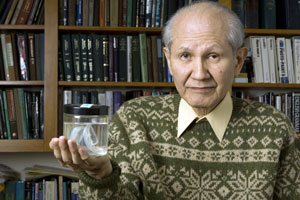 |
Osamu Shimomura holds Aequorea specimens that he collected in 1999 at Friday Harbor Laboratories, University of Washington. Credit: Tom Kleindinst
|
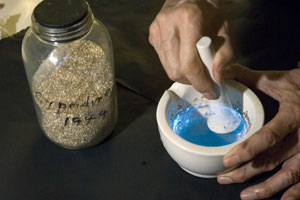 |
Osamu Shimomura demonstrates the bioluminescence of the sea firefly, Cipridina, a small crustacean collected off the coast of Japan. Shimomura was the first person to purify the light-emitting luciferin molecule from Cipridina in 1956, an accomplishment that launched his scientific career. Credit: Tom Kleindinst
|
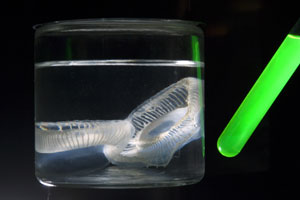 |
Aequorea jellyfish that Osamu Shimomura collected in 1999 at Friday Harbor Laboratories, University of Washington, with a test tube of GFP that Shimomura purified from 20,000 Aequorea specimens. Credit: Tom Kleindinst
|
|